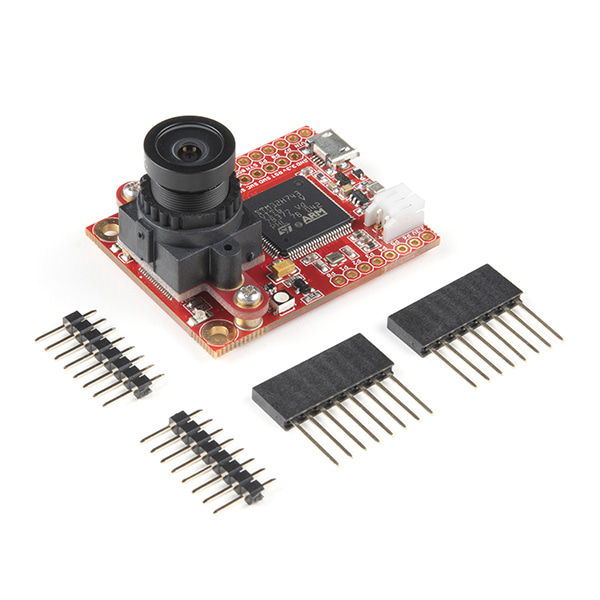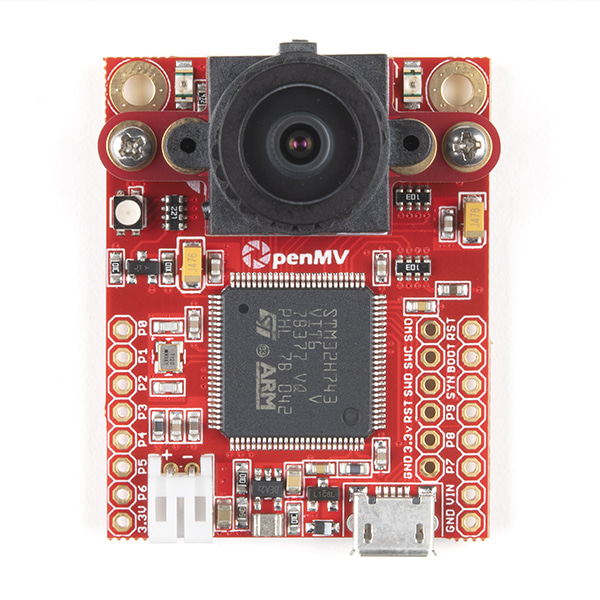OpenMV H7 R2 카메라 -오픈 머신 비전 개발 플랫폼
(OpenMV Cam H7 R2)


개요
- 본 제품은 OpenMV H7 R2 카메라 모듈입니다.
- 머신 비전을 쉽게 구현할 수 있게 한 작고 저전력 마이크로컨트롤러 보드입니다.
- 이미지를 캡쳐할 수 있을 뿐아니라 얼굴을 검출하거나 컬러를 트래킹, QR 코드 읽기 등등의 태스크를 수행할 수 있습니다.
- 본 제품은 파이썬 스크립트를 이용하여 프로그래밍이 가능하여 복잡한 머신비전 알고리즘 출력을 쉽게 다루고, 좀더 하이레벨의 데이터 구조로 작업을 할 수 있게 합니다.
- 외부 이벤트를 이용하여 쉽게 사진을 찍거나 비디오를 찍을 수 있으며, IO 핀 제어를 위한 머신비전 알고리즘을 실행할 수 있습니다
- 2592x1944(5MP) 이미지를 찍을 수 있는 MT9M114 이미지 센서를 장착하고 있습니다.
- MT9M114 이미지 센서를 제외한 기존 OV7725 센서를 장착한 OpenMV H7 Plus와 동일한 제품입니다.
- 두개의 센서는 서로 다르게 동작하기 때문에 OpenMV IDE를 사용시 참고 부탁 드립니다.
특징
- The STM32H743II ARM Cortex M7 processor running at 480 MHz with 32MBs SDRAM + 1MB of SRAM and 32 MB of external flash + 2 MB of internal flash. All I/O pins output 3.3V and are 5V tolerant. The processor has the following I/O interfaces:
- A full speed USB (12Mbs) interface to your computer. Your OpenMV Cam will appear as a Virtual COM Port and a USB Flash Drive when plugged in.
- A μSD Card socket capable of 100Mbs reads/writes which allows your OpenMV Cam to take pictures and easily pull machine vision assets off of the μSD card.
- A SPI bus that can run up to 80Mbs allowing you to easily stream image data off the system to either the LCD Shield, the WiFi Shield, or another microcontroller.
- An I2C Bus (up to 1Mb/s), CAN Bus (up to 1Mb/s), and an Asynchronous Serial Bus (TX/RX, up to 7.5Mb/s) for interfacing with other microcontrollers and sensors.
- A 12-bit ADC and a 12-bit DAC.
- Two I/O pins for servo control.
- Interrupts and PWM on all I/O pins (there are 10 I/O pins on the board).
- And, an RGB LED and two high power 850nm IR LEDs.
- 32 MB of external 32-bit SDRAM clocked at 100 MHz for 400 MB/s of bandwidth.
- 32 MB of external quadspi flash clocked at 100 MHz in 4-bit DDR mode for 100 MB/s of bandwidth (read speed).
- A removable camera module system allowing the OpenMV Cam H7 to interface with different sensors:
- The OpenMV Cam H7 Plus comes with a MT9M114 image sensor is capable of taking 2592x1944 (5MP) images. Most simple algorithms will run between 25-50 FPS on QVGA (320x240) resolutions and below. Your image sensor comes with a 2.8mm lens on a standard M12 lens mount. If you want to use more specialized lenses with your image sensor you can easily buy and attach them yourself.
- For professional machine vision applications you can buy our Global Shutter Camera Module.
- For thermal machine vision applications you can buy our FLIR Lepton Adapter Module.
- A LiPo battery connector compatible with 3.7V LiPo batteries commonly sold online for hobbyist robotic applications.
-
The OpenMV H7 R2 Camera is a small, low power, microcontroller board which allows you to easily implement applications using machine vision in the real-world. The Plus variation adds 32 MB of external 32-bit SDRAM and 32 MB of external quad SPI flash. You program the OpenMV Cam in high level Python scripts (courtesy of the MicroPython Operating System) instead of C/C++. This makes it easier to deal with the complex outputs of machine vision algorithms and working with high level data structures. But, you still have total control over your OpenMV Cam and its I/O pins in Python. You can easily trigger taking pictures and video on external events or execute machine vision algorithms to figure out how to control your I/O pins.
The OpenMV Cam H7 R2 comes with a MT9M114 image sensor is capable of taking 2592x1944 (5MP) images. Most simple algorithms will run between 25-50 FPS on QVGA (320x240) resolutions and below. Additionally, the OpenMV H7 R2 now features removable camera modules which allow you to use the module with Global Shutter and FLIR Lepton sensors for serious computer vision applications. The OpenMV is perfect for applications involving frame differencing, face detection, eye and marker tracking, QR code detection/decoding, shape detection, and more.
This camera is a near identical version of the OpenMV H7 Plus, but with a different imaging sensor; the MT9M114 instead of the OV7725. Please keep this in mind when using the OpenMV IDE since the two sensors operate differently.
문서
- Base Schematic
- OV5640 Schematic
- OpenMV Camera Tutorial
- OpenMV IDE
- On-Board Module Datasheets
- Document Page
- OpenMV Resource Page
-
Uses include:
- Frame Differencing
- Color Tracking
- Marker Tracking
- Face Detection
- Eye Tracking
- Optical Flow
- QR Code Detection/Decoding
- Data Matrix Detection/Decoding
- Linear Barcode Decoding
- AprilTag Tracking
- Line Detection
- Shape Detection
- Template Matching
- Image Capture
- Video Recording